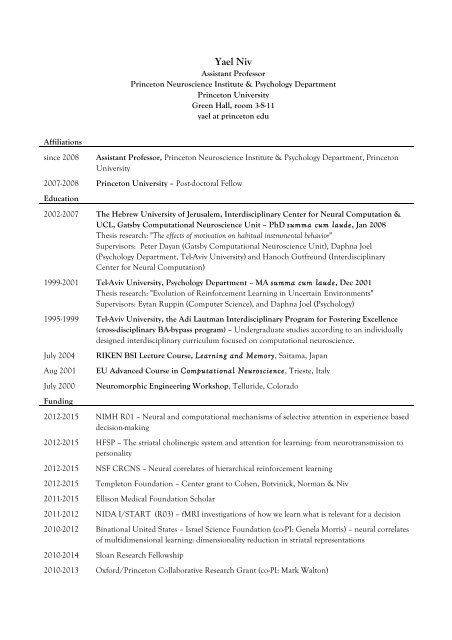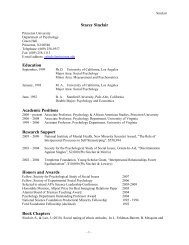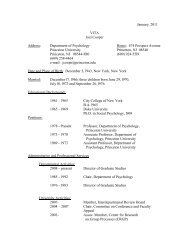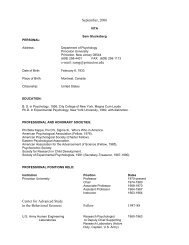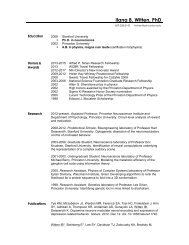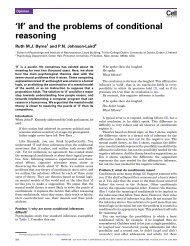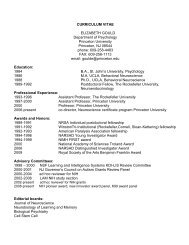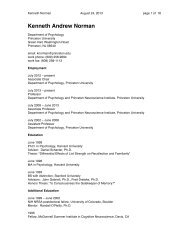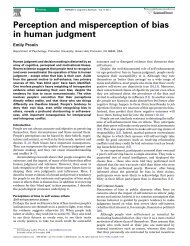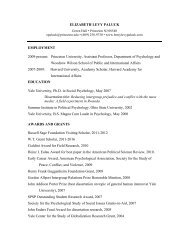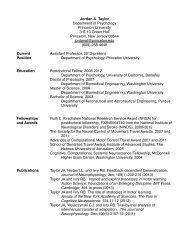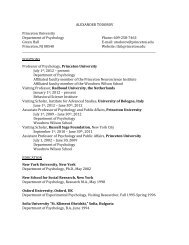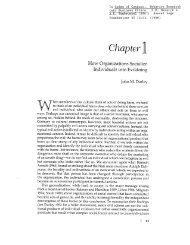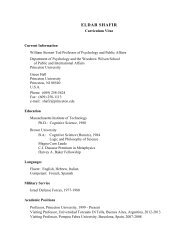Yael Niv - Department of Psychology - Princeton University
Yael Niv - Department of Psychology - Princeton University
Yael Niv - Department of Psychology - Princeton University
You also want an ePaper? Increase the reach of your titles
YUMPU automatically turns print PDFs into web optimized ePapers that Google loves.
<strong>Yael</strong> <strong>Niv</strong>Assistant Pr<strong>of</strong>essor<strong>Princeton</strong> Neuroscience Institute & <strong>Psychology</strong> <strong>Department</strong><strong>Princeton</strong> <strong>University</strong>Green Hall, room 3-S-11yael at princeton eduAffiliationssince 2008Assistant Pr<strong>of</strong>essor, <strong>Princeton</strong> Neuroscience Institute & <strong>Psychology</strong> <strong>Department</strong>, <strong>Princeton</strong><strong>University</strong>2007-2008 <strong>Princeton</strong> <strong>University</strong> – Post-doctoral FellowEducation2002-2007 The Hebrew <strong>University</strong> <strong>of</strong> Jerusalem, Interdisciplinary Center for Neural Computation &UCL, Gatsby Computational Neuroscience Unit – PhD summa cum laude, Jan 2008Thesis research: "The effects <strong>of</strong> motivation on habitual instrumental behavior"Supervisors: Peter Dayan (Gatsby Computational Neuroscience Unit), Daphna Joel(<strong>Psychology</strong> <strong>Department</strong>, Tel-Aviv <strong>University</strong>) and Hanoch Gutfreund (InterdisciplinaryCenter for Neural Computation)1999-2001 Tel-Aviv <strong>University</strong>, <strong>Psychology</strong> <strong>Department</strong> – MA summa cum laude, Dec 2001Thesis research: "Evolution <strong>of</strong> Reinforcement Learning in Uncertain Environments"Supervisors: Eytan Ruppin (Computer Science), and Daphna Joel (<strong>Psychology</strong>)1995-1999 Tel-Aviv <strong>University</strong>, the Adi Lautman Interdisciplinary Program for Fostering Excellence(cross-disciplinary BA-bypass program) – Undergraduate studies according to an individuallydesigned interdisciplinary curriculum focused on computational neuroscience.July 2004Aug 2001July 2000FundingRIKEN BSI Lecture Course, Learning and Memory, Saitama, JapanEU Advanced Course in Computational Neuroscience, Trieste, ItalyNeuromorphic Engineering Workshop, Telluride, Colorado2012-2015 NIMH R01 – Neural and computational mechanisms <strong>of</strong> selective attention in experience baseddecision-making2012-2015 HFSP – The striatal cholinergic system and attention for learning: from neurotransmission topersonality2012-2015 NSF CRCNS – Neural correlates <strong>of</strong> hierarchical reinforcement learning2012-2015 Templeton Foundation – Center grant to Cohen, Botvinick, Norman & <strong>Niv</strong>2011-2015 Ellison Medical Foundation Scholar2011-2012 NIDA I/START (R03) – fMRI investigations <strong>of</strong> how we learn what is relevant for a decision2010-2012 Binational United States – Israel Science Foundation (co-PI: Genela Morris) – neural correlates<strong>of</strong> multidimensional learning: dimensionality reduction in striatal representations2010-2014 Sloan Research Fellowship2010-2013 Oxford/<strong>Princeton</strong> Collaborative Research Grant (co-PI: Mark Walton)
Funding to trainees, sponsored or co-sponsored2011-2014 Howard Hughes Medical Institute International Student Research Fellowship (Eran Eldar)2010-2013 NSF Graduate Research Fellowship (Sam Gershman)Fellowships & Awards2011-2015 Ellison Medical Foundation Scholar2010-2012 Alfred P. Sloan Research Fellow2007-2008 Human Frontiers Science Program, Long term post-doctoral fellowship “How we learn what isrelevant: fMRI <strong>of</strong> prefrontal-basal ganglia interactions in uninstructed tasks”2008 The Hebrew <strong>University</strong> <strong>of</strong> Jerusalem – Max Schlomiuk award for outstanding PhD thesis2007 Rothschild post-doctoral fellowship (declined)2004-2006 Rector’s Excellence PhD fellowship, Hebrew <strong>University</strong>2005 NIPS Outstanding Student Paper award, “How fast to work: Response vigor, motivation and tonicdopamine”2001-2004 Merit based scholarship, Interdisciplinary Center for Neural Computation2004 CNS Best Talk award, “The Effects <strong>of</strong> Uncertainty on TD Learning”2004 Dan David Scholarship for PhD Graduate Students in the field <strong>of</strong> Brain Sciences2003 EC Thematic Network Fellowship for short-term academic visit to the Gatsby ComputationalNeuroscience Unit, UCL1996-1997 Adi Lautman Interdisciplinary Program for Fostering Excellence - two years outstandingachievements award1995-1999 Merit based scholarship, Adi Lautman Interdisciplinary Program for Fostering ExcellencePeer reviewed publicationsInpreparationSJ Gershman, KA Norman & Y <strong>Niv</strong> – Statistical computation underlying the dynamics <strong>of</strong> memoryUnderreviewFA Soto, SJ Gershman & Y <strong>Niv</strong> – A Rational Bayesian Model <strong>of</strong> the Effect <strong>of</strong> Stimulus Factors onCompound GeneralizationSJ Gershman, CJ Jones, KA Norman, M-H Monfils & Y <strong>Niv</strong> – Gradual extinction eliminates thespontaneous recovery <strong>of</strong> fearRC Wilson, YK Takahashi, G Schoenbaum & Y <strong>Niv</strong> – Orbit<strong>of</strong>rontal cortex encodes a cognitivemap <strong>of</strong> task spaceE Eldar, JD Cohen & Y <strong>Niv</strong> – Neural gain and flexibility in learningSJ Gershman & Y <strong>Niv</strong> – Categorical perception obeys Occam’s razorSJ Gershman & Y <strong>Niv</strong> – Novelty and inductive generalization in human reinforcement learning2013 C Diuk, K Tsai, JD Wallis, MM Botvinick & Y <strong>Niv</strong> (in press)– Two simultaneous, but separable,prediction errors in human ventral striatum2012 SJ Gershman & Y <strong>Niv</strong> (2012) – Exploring a latent cause theory <strong>of</strong> classical conditioning – Learning& Behavior 40:255-268
F Lucantonio, TA Stalnaker, Y Shaham, Y <strong>Niv</strong> & G Schoenbaum (2012) – The impact <strong>of</strong>orbit<strong>of</strong>rontal dysfunction on cocaine addiction – Nature Neuroscience 15(3):358-366RC Wilson & Y <strong>Niv</strong> (2012) – Inferring relevance in a changing world – Frontiers in HumanNeuroscience 5:189. doi:10.3389/fnhum.2011.00189Y <strong>Niv</strong>, J Edlund, P Dayan & JP O’Doherty (2012) – Neural prediction errors reveal a risk-sensitivereinforcement learning process in the human brain – J Neuroscience 32(2):551-5622011 YK Takahashi, MR Roesch, RC Wilson, K Toreson, P O’Donnell, Y <strong>Niv</strong>* & GSchoenbaum* (2011) – Expectancy-related changes in firing <strong>of</strong> dopamine neurons depend onorbit<strong>of</strong>rontal cortex – Nature Neuroscience 14(12):1590-1597* Equally contributing senior authorsE Eldar, G Morris & Y <strong>Niv</strong> (2011) – The effects <strong>of</strong> motivation on response rate: A hidden semi-Markov model analysis <strong>of</strong> behavioral dynamics – Journal <strong>of</strong> Neuroscience Methods 201:251-261JJF Ribas-Fernandes, A Solway, C Diuk, JT McGuire, AG Barto, Y <strong>Niv</strong> & MM Botvinick(2011) – A neural signature <strong>of</strong> hierarchical reinforcement learning – Neuron 71:370-379M McDannald, F Lucantonio, K Burke, Y <strong>Niv</strong> & G Schoenbaum (2011) – Ventral striatumand orbit<strong>of</strong>rontal cortex are both required for model-based, but not model-free, reinforcement learning –Journal <strong>of</strong> Neuroscience 31(7):2700-27052010 SJ Gershman, JD Cohen & Y <strong>Niv</strong> (2010) – Learning to selectively attend – Proceedings <strong>of</strong> the32 nd Annual Conference <strong>of</strong> the Cognitive Science SocietySJ Gershman & Y <strong>Niv</strong> (2010) – Learning latent structure: Carving nature at its joints – CurrentOpinion in Neurobiology 20(2):251–256 (Special issue on Cognitive Neuroscience)SJ Gershman, DM Blei & Y <strong>Niv</strong> (2010) – Context, Learning and Extinction – PsychologicalReview, 117(1):197-2092009 MT Todd, Y <strong>Niv</strong> & JD Cohen (2009) – Learning to use working memory in partially observableenvironments through dopaminergic reinforcement, In: D Koller, D Schuurmans, Y Bengio & LBottou, eds., Advances in Neural Information Processing Systems 21, 1689–1696Y <strong>Niv</strong> (2009) – Reinforcement learning and the brain, Journal <strong>of</strong> Mathematical <strong>Psychology</strong> 53(3),139-154 (special issue on partially observable Markov decision processes)MM Botvinick, Y <strong>Niv</strong> & AC Barto (2009) – Hierarchically organized behavior and its neuralfoundations: A reinforcement-learning perspective, Cognition 113, 262–2802008 P Dayan & Y <strong>Niv</strong> (2008) – Reinforcement learning: The Good, The Bad, and The Ugly, CurrentOpinion in Neurobiology, 18(2), 185-196 (special issue on Cognitive Neuroscience)Y Takahashi, G Schoenbaum & Y <strong>Niv</strong> (2008) – Silencing the Critics: Understanding the effects <strong>of</strong>cocaine sensitization on dorsal and ventral striatum in the context <strong>of</strong> an Actor/Critic model, Frontiersin Neuroscience 2, 86-99D Schiller, I Levy, Y <strong>Niv</strong>, JE LeDoux & EA Phelps (2008) – From fear to safety and back –Reversal <strong>of</strong> fear in the human brain, The Journal <strong>of</strong> Neuroscience 28(45), 11517-11525Y <strong>Niv</strong> & G Schoenbaum (2008) – Dialogues on prediction errors, Trends in Cognitive Sciences12(7): 265-2722007 Y <strong>Niv</strong>, ND Daw, D Joel & P Dayan (2007) – Tonic dopamine: Opportunity costs and the control <strong>of</strong>response vigor – Psychopharmacology 191(3), 507-520 (special issue on dopamine)
Y <strong>Niv</strong> (2007) – Cost, Benefit, Tonic Phasic: What do response rates tell us about dopamine andmotivation? – Annals <strong>of</strong> the New York Academy <strong>of</strong> Science 1104, 357-3762006 Y <strong>Niv</strong>, D Joel & P Dayan (2006) – A normative perspective on motivation – Trends in CognitiveSciences 10(8), 375-381P Dayan, Y <strong>Niv</strong>, B Seymour & ND Daw (2006) – The misbehavior <strong>of</strong> value and the discipline <strong>of</strong>the will – Neural Networks 19(8), 1153-1160 (special issue on decision making)2005 Y <strong>Niv</strong>, ND Daw & P Dayan (2005) – How fast to work: Response vigor, motivation and tonicdopamine – In: Y. Weiss, B. Schölkopf and J. Platt, eds., Neural Information Processing Systems18, 1019-1026, MIT Press (Conference Talk, Outstanding Student Paper Award)ND Daw, Y <strong>Niv</strong> & P Dayan (2005) – Uncertainty based competition between prefrontal anddorsolateral striatal systems for behavioral control – Nature Neuroscience, 8(12),1704-1711Y <strong>Niv</strong>, MO Duff & P Dayan (2005) – Dopamine, uncertainty and TD learning – Behavioral andBrain Functions 1:62002 Y <strong>Niv</strong>, D Joel, I Meilijson & E Ruppin (2002) – Evolution <strong>of</strong> reinforcement learning in uncertainenvironments: A simple explanation for complex foraging behaviors – Adaptive Behavior 10(1), 5-24D Joel, Y <strong>Niv</strong> & E Ruppin (2002) – Actor-critic models <strong>of</strong> the basal ganglia: New anatomical andcomputational perspectives – Neural Networks 15, 535-5472001 Y <strong>Niv</strong>, D Joel, I Meilijson & E Ruppin (2001) – Evolution <strong>of</strong> reinforcement learning in foragingbees: A simple explanation for risk averse behavior – Neurocomputing 44(1), 951-956Commentaries, chapters, technical reports2012 C Diuk, A Schapiro, N Cordova, Y <strong>Niv</strong> & MM Botvinick (in press) – Divide and conquer:Hierarchical reinforcement learning and task decomposition in humans. In: G Baldassare & M Mirollieds., Computational and Robotic Models <strong>of</strong> the Hierarchical Organization <strong>of</strong> Behavior,Springer VerlagMM Botvinick, Y <strong>Niv</strong> & A Barto (2012) – Hierarchically organized behavior and its neuralfoundations: A reinforcement learning perspective. In: A Seth, T Prescott & J Bryson, eds.,Modelling Natural Action Selection, pp. 264-269, Cambridge: Cambridge <strong>University</strong> Press2011 Y <strong>Niv</strong> & S Chan (2011) – On the value <strong>of</strong> information and other rewards – Nature Neuroscience14(9), 1095-1097JJF Ribas-Fernandes, Y <strong>Niv</strong> & MM Botvinick (2011) – Neural correlates <strong>of</strong> hierarchicalreinforcement learning In: RB Mars, J Sallet MFS Rushworth & N Yeung, eds., Neural basis <strong>of</strong>motivational and cognitive control, Chapter 17, pp. 285-310, MIT Press2008 Y <strong>Niv</strong> & PR Montague (2008) – Theoretical and Empirical Studies <strong>of</strong> Learning – In: P.W.Glimcher, C.F. Camerer, E. Fehr & R.A. Poldrack, eds., Neuroeconomics: Decision makingand the brain, Chapter 22, pp. 329-349, ElsevierP Dayan, ND Daw & Y <strong>Niv</strong> (2008) –Learning, action, inference and neuromodulation – In: L.Squire et al, eds., Encyclopedia <strong>of</strong> Neuroscience, Elsevier, Amsterdam2007 Y <strong>Niv</strong> & M Rivlin-Etzion (2007) – Parkinson’s disease: Fighting the will? – Journal <strong>of</strong>Neuroscience, 24(44), 11777-117792006 Y <strong>Niv</strong>, ND Daw & P Dayan (2006) - Choice values - Nature Neuroscience 9(8), 987-988ND Daw, Y <strong>Niv</strong> & P Dayan (2006) - Actions, policies, values, and the basal ganglia – In: Bezard,
E. editor, Recent Breakthroughs in Basal Ganglia Research, Nova Science Publishers Inc., NewYork, USAY <strong>Niv</strong>, P Dayan & D Joel (2006) - The effects <strong>of</strong> motivation on extensively trained behavior - LeibnizTechnical Report, Hebrew <strong>University</strong>, 2006-6Abstracts2012 E Eldar, A Radulescu, Y <strong>Niv</strong> & JD Cohen (2012) – Norepinephrine, neural gain, and "first onewins" network dynamics – COSYNE 2012: Computational and Systems Neuroscience, Salt LakeCity, UtahC Diuk, D Yee, JJF Ribas-Fernandes, N Cordova, A Schapiro, Y <strong>Niv</strong> & MM Botvinick(2012) – Divide and conquer: Task decomposition in humans – Society for Neuroscience Abstracts38:592.20E Eldar & Y <strong>Niv</strong> (2012) – Learning about what you learn best: norepinephrine, neural gain, and localprocessing – Society for Neuroscience Abstracts 38:592.11A Geana & Y <strong>Niv</strong> (2012) – Do we pay attention to the forest or the trees? A comparison <strong>of</strong> learningmodels using real-time task design – Society for Neuroscience AbstractsY Leong & Y <strong>Niv</strong> (2012) – The role <strong>of</strong> selective attention in learning – Society for NeuroscienceAbstracts 38:592.12A Radulescu & Y <strong>Niv</strong> (2012) – Age related differences in learning to selectively attend – Society forNeuroscience Abstracts 38:592.15RC Wilson, YK Takahashi, G Schoenbaum & Y <strong>Niv</strong> (2012) – Orbit<strong>of</strong>rontal cortex as a cognitivemap <strong>of</strong> task space: implications for reversal learning and extinction – Society for NeuroscienceAbstracts 38:289.172011 C Diuk, MM Botvinick & Y <strong>Niv</strong> (2011) – Two coincident but separable prediction errors in humanventral striatum – Society for Neuroscience Abstracts 37:827.142010 C Diuk, A Barto, MM Botvinick & Y <strong>Niv</strong> (2010) – Hierarchical Reinforcement Learning: AnfMRI Study <strong>of</strong> learning in a two-level gambling task – Society for Neuroscience Abstracts 36:907.13MA McDannald, F Lucantonio, KA Burke, Y <strong>Niv</strong> & G Schoenbaum (2010) – Differentcritical roles for ventral striatum and orbit<strong>of</strong>rontal cortex in learning driven by changes in value versusidentity – Society for Neuroscience Abstracts 36:707.8Y <strong>Niv</strong> & SJ Gershman (2010) – Representation learning and reinforcement learning: An fMRI study<strong>of</strong> learning to selectively attend – Society for Neuroscience Abstracts 36:907.15N Lopatina, T Thamrongrattanarit, G Schoenbaum & Y <strong>Niv</strong> (2010) – Human learning in atransreinforcer blocking paradigm – Pavlovian Society Meeting, Baltimore, MarylandYK Takahashi, MR Roesch, RC Wilson, Y <strong>Niv</strong>, K Toreson, P O’Donnell & G Schoenbaum(2010) – Orbit<strong>of</strong>rontal cortex is required for expectancy-related changes in phasic firing <strong>of</strong> midbraindopamine neurons – Society for Neuroscience Abstracts 36:404.1MT Todd, Y <strong>Niv</strong> & JD Cohen (2010) – Identifying internal representations <strong>of</strong> context in fMRI –Society for Neuroscience Abstracts 36RC Wilson, JD Cohen & Y <strong>Niv</strong> (2010) – Inferring relevance in a changing world – Society forNeuroscience Abstracts 36:907.12RC Wilson, YK Takahashi, MR Roesch, T Stalnaker, G Schoenbaum & Y <strong>Niv</strong> (2010) – AComputational Model <strong>of</strong> the Role <strong>of</strong> Orbit<strong>of</strong>rontal Cortex and Ventral Striatum in Signalling Reward
Expectancy in Reinforcement Learning – Society for Neuroscience Abstracts 36:404.1A Christakou, S Gershman, Y <strong>Niv</strong>, M Brammer & K Rubia (2010) – Temporal DifferenceModeling <strong>of</strong> Decision-making Under Ambiguity: Application in Adolescent Development – Motivationaland Cognitive Control Meeting, June 2010, Oxford, UK2009 S Gershman, D Blei & Y <strong>Niv</strong> (2009, talk) –An Infinite Mixture Model <strong>of</strong> Context-dependentLearning and Extinction – COSYNE 2009: Computational and Systems Neuroscience, Salt LakeCity, UtahJ Fernandes, J McGuire, Y <strong>Niv</strong> & MM Botvinick (2010) – Neural correlates <strong>of</strong> hierarchicalreinforcement learning: An fMRI study – Society for Neuroscience Abstracts 35:102.162008 Y <strong>Niv</strong>, J Edlund, P Dayan & JP O’Doherty (2008, talk) –Neural prediction errors reveal risksensitivity in instrumental choice – Israeli Human Brain Mapping 2008, Tel Aviv, IsraelY <strong>Niv</strong>, P Dayan & JP O’Doherty (2008, poster and spotlight presentation) – Decision making:Neural prediction errors show risk sensitivity – COSYNE 2008: Computational and SystemsNeuroscience, Salt Lake City, Utah2007 D Schiller, Y <strong>Niv</strong>, I Levy, JE LeDoux & EA Phelps (2007, poster and featured shortpresentation) – Reversal <strong>of</strong> fear learning in the human brain – Linking Affect to Action: CriticalContributions <strong>of</strong> the Orbit<strong>of</strong>rontal Cortex, NYAS Symposium, New York, NY2006 Y <strong>Niv</strong>, JA Edlund, P Dayan & JP O’Doherty (2006, poster) – Neural correlates <strong>of</strong> risk sensitivity:An fMRI study <strong>of</strong> instrumental choice behavior – Society for Neuroscience Abstracts 32:664.8,Atlanta, Georgia2005 Y <strong>Niv</strong>, ND Daw & P Dayan (2005, poster) – The effects <strong>of</strong> motivation on rates <strong>of</strong> responding: Areinforcement learning approach – European Brain and Behavior Society Meeting, Dublin, IrelandY <strong>Niv</strong>, P Dayan & D Joel (2005, talk) – The effects <strong>of</strong> motivation on habitual behavior –Associative Learning Symposium 2005, Gregynog, WalesY <strong>Niv</strong>, ND Daw, D Joel & P Dayan (2005, poster) – Motivational effects on behavior: Towards areinforcement learning model <strong>of</strong> rates <strong>of</strong> responding – COSYNE 2005: Computational and SystemsNeuroscience, Salt Lake City, UtahND Daw, Y <strong>Niv</strong> & P Dayan (2005, talk) – Uncertainty-based competition between prefrontal andstriatal systems for behavioural control – COSYNE 2005: Computational and SystemsNeuroscience, Salt Lake City, Utah2004 Y <strong>Niv</strong>, MO Duff & P Dayan (2004, poster) – Asymmetric coding <strong>of</strong> temporal difference errors:Implications for dopamine firing patterns - IBAGS VIII: The 8th Triennial Meeting <strong>of</strong> theInternational Basal Ganglia Society, Crieff, ScotlandY <strong>Niv</strong>, MO Duff & P Dayan (2004, talk) – Dopamine, uncertainty and TD learning - CNS2004:The 13 th Annual Computational Neuroscience Meeting, Baltimore, MarylandY <strong>Niv</strong>, MO Duff & P Dayan (2004,talk) - The effects <strong>of</strong> uncertainty on TD learning - COSYNE2004: Computational and Systems Neuroscience, New York, NY2001 Y <strong>Niv</strong>, D Joel, I Meilijson & E Ruppin (2001) – Evolution <strong>of</strong> reinforcement learning in uncertainenvironments: Emergence <strong>of</strong> risk aversion and probability matching – In: J. Kelemen and P. Sosik eds.,Advances in Artificial Life - Proceedings <strong>of</strong> the 6 th European Conference, ECAL 2001, Prague,252-261Theses
2007 PhD Thesis – Interdisciplinary Center for Neural Computation, The Hebrew <strong>University</strong> <strong>of</strong>Jerusalem: The effects <strong>of</strong> motivation on habitual instrumental behavior2001 MA Thesis – <strong>Psychology</strong> <strong>Department</strong>, Tel Aviv <strong>University</strong>: Evolution <strong>of</strong> Reinforcement Learningin Uncertain EnvironmentsWorkshops/Conferences organized2012 “Rumelhart Symposium” in honor <strong>of</strong> Peter Dayan at CogSci2012 – The annual meeting <strong>of</strong>the Cognitive Science Society, August 1-4 2012, Sapporo, Japan (co-organizer: Nathaniel Daw)2010 “Batsheva Seminar on Reward and Decision Making in the Brain”, February 16-20,Jerusalem, Israel (co-organizers: Hagai Bergman, Daphna Joel)2007 NIPS Workshop: “Hierarchical organization <strong>of</strong> behavior: Computational, psychological andneural perspectives”, December 7-8 (co-organizers: Matthew Botvinick and Andrew Barto)2005 Gatsby Foundation Workshop: “Motivation and action selection”, June 20-22(co-organizers: Nathaniel Daw and Peter Dayan)Invited talks/Seminars2012 Workshop 2: Cognitive Neuroscience – Invited talk (December 2012)Neural Computation: From Perception to Cognitive Function, Berlin – Invited talk(October 2012)Annual meeting <strong>of</strong> the Society for Neuroeconomics – Invited workshop talk (September2012)ESF Workshop on “Motivation and Action”, Copenhagen – Invited talk (August 2012)Washington <strong>University</strong>, St. Louis – Cognitive, Computational and Systems Neuroscience(CCSN) Invited Lecturer (May 2012)NIDA – Invited lecture (May 2012)NIH/NINDS – Invited lecture (May 2012)Case Western Reserve – EECS <strong>Department</strong> Colloquium – Invited talk (planned)TEDxRutgers – Invited talk “How do we make decisions” (April 2012)<strong>University</strong> <strong>of</strong> Michigan, Ann Arbor - Biopsychology Colloquium series – Invited talk (April2012)Stanford Mind Brain and Computation symposium – “Reinforcement learning:Computational roles for dopamine, striatum, and hippocampus” – Invited talk (Feb 2012)2011 NYU – Memory in Brain Lecture Series – Invited talk (October 2011)Columbia <strong>University</strong> – Cognitive Lunch Series – Invited talk (September 2011)Gordon Conference on Eye Movements – Invited talk “Mechanisms <strong>of</strong> attention in theservice <strong>of</strong> reward learning” (August 2011)Workshop on the Neuroscience and Psychophysiology <strong>of</strong> Experience-Based Decisions –Technion <strong>University</strong> – Invited talk (June 2011)Association for Behavioral Analysis International (ABAI ) annual convention, B. F. SkinnerLecture Series – Invited talk – “Learning latent structure” (May 2011)Computational Systems Neuroscience (COSYNE) 2011 – invited talk in workshop on
“Attention, reinforcement learning and reward”Winter Conference on Brain Research – Invited talk in symposium on “Two brains are betterthan one: Multiple learning systems for economic decision making”Winter Conference on Brain Research – Invited talk in symposium on “How do we learnwhat outcomes to expect from a decision? Investigations into the neural circuits mediatingmodel-based learning about reward value versus identity”2010 Institute for Research in Cognitive Science Colloquium Series, <strong>University</strong> <strong>of</strong> Pennsylvania,Invited seminar (December 2010)BCS Colloquium Series, <strong>University</strong> <strong>of</strong> Rochester, <strong>Department</strong> <strong>of</strong> Brain and CognitiveScience, Invited seminar (September 2010)FIL Brain Meeting series, UCL, Invited Seminar (May 2010)Computations, Decisions, and Movement, Rauischholzhausen Castle, Germany, Invitedtalk (May 2010)Intelligence Seminar Series, Carnegie Mellon <strong>University</strong>, School <strong>of</strong> Computer Science,Invited seminar (March 2010)2009 “Model-driven studies <strong>of</strong> learning and decision making” Invited feature presentation, 2009Sloan-Swartz Annual Meeting on Theoretical Neuroscience, Harvard (July 2009)“The Neuroscience <strong>of</strong> Reinforcement learning” Invited tutorial, The 26 th InternationalConference on Machine Learning http://www.princeton.edu/~yael/ICMLtutorial2009(June 2009)“Risk sensitivity: What does reinforcement learning have to do with it?” Invited seminar, Yale<strong>University</strong> School <strong>of</strong> Medicine (February 2009)2008 “Reconciling reinforcement learning and risk sensitivity: a model-based fMRI study” Invitedtalk, NIPS 2008 Workshop on Machine Learning Meets Human Learninghttp://pages.cs.wisc.edu/~jerryzhu/nips08.html (December 2008)“Dealing with risk in the perception-action cycle” Invited talk, NIPS 2008 Minisymposium onPrincipled Theoretical Frameworks for the Perception-Action Cyclehttp://homepages.feis.herts.ac.uk/~comqdp1/NIPS_2008/NIPS_Symposium_Workshop.html (December 2008)“Better safe than sorry? Neural prediction errors reveal subjective risk sensitivity” Invitedseminar, Center for Cognitive Sciences colloquium series, <strong>University</strong> <strong>of</strong> Minnesotahttp://www.cogsci.umn.edu/calendar/colloquia.htm (November 2008)“Attitudes to risk: what does reinforcement learning have to do with it?”, Invited talk,Workshop on Open Problems in Neuroscience <strong>of</strong> Decision Making, Okinawa, Japanhttp://www.irp.oist.jp/nc/odm/ (October 2008)“Silencing the critics: An Actor/Critic view on substance abuse”, Invited talk, InternationalSymposium on Drug Addiction: Mechanisms and Therapeutic Approaches, Kunming,China (October 2008)“Neural prediction errors reveal risk-sensitivity in instrumental choice”, invited seminar,Industrial Engineering, Technion (August 2008)“Optimal decision making: from dopamine to habits and back”, invited seminar, BiologicalNetworks Group, Technion (July 2008)
“How we (might) use reinforcement learning to decide how fast to move” in: “How fast?”Trajectory control, movement energy, and the basal ganglia, Symposium in the Annual Meeting <strong>of</strong>the Society for the Neural Control <strong>of</strong> Movement, Naples, Florida (May 2008)“How animals (might) use RL to decide how fast to work”, Fast Reinforcement Learningmeeting, Barbados (April 2008)“Tonic dopamine, motivation and the optimal choice <strong>of</strong> response rates”, Neural circuits anddecision making in rodents, Invited talk, Janelia Farm, (April 2008)Neurotheory Seminar Series, Columbia <strong>University</strong> (February 2008)2007 “Opportunity costs and response rates: How dopamine helps us choose how hard to work”,invited seminar, BMS seminar series, Caltech (November 2007)“Reinforcement learning and free operant behavior: from motivation to optimal selection <strong>of</strong>response vigor”, invited seminar, H<strong>of</strong>stra <strong>University</strong>, NY (October 2007)“Hierarchical reinforcement learning: What is it, and why should we care?”, ChampalimaudNeuroscience Workshop: Neural bases <strong>of</strong> reward and decision making 2.0, Invited talk,Lisbon, Portugal (September 2007)“Contrasting risk-sensitive and risk-neutral learning in an fMRI study <strong>of</strong> instrumental choice”,Neur<strong>of</strong>inance symposium on The neural bases for human decision making underuncertainty, Invited talk, <strong>University</strong> <strong>of</strong> Zurich (July 2007)“Computationally linking dopamine and vigor: motivation bridges the gap”,Schoenbaum/O’Donnell labs’ Systems journal club, invited seminar, <strong>University</strong> <strong>of</strong> Maryland(May 2007)2006 “Cost, benefit, tonic, phasic: What does response vigor tell us about dopamine andmotivation?”, invited seminar, Neuroeconomics seminar series, NYU (Nov 2006)“Cost, benefit, tonic, phasic: What does response vigor tell us about dopamine andmotivation?”, Workshop on Reward and decision making in cortico-basal ganglianetworks, invited talk, Lake Arrowhead, California (June 2006)“Choosing how hard to work: A normative account <strong>of</strong> response vigor, motivation and tonicdopamine”, <strong>Psychology</strong> department, invited seminar, Cambridge <strong>University</strong> (July 2006)“Dealing with change: Learned and immediate effects <strong>of</strong> changes in subjective reward utility,on behavior”, Symposium on Choice and the Brain, invited talk, California Institute <strong>of</strong>Technology (June 2006)Tsodyks Lab, invited seminar, Weizmann Institute (April 2006)“Dopamine and reward”, Course on Schizophrenia: A Systems Neuroscience Perspective,invited lecture, Weizmann Institute (April 2006)Rushworth Lab, invited seminar, Cambridge, UK (Jan 2006)2005 Montague Lab, invited seminar, Baylor College <strong>of</strong> Medicine (Nov 2005)“Deciding how hard to work: A normative account <strong>of</strong> response vigor, motivation and tonicdopamine”, invited talk, Computational Cognitive Neuroscience Conference (Nov 2005)Phelps Lab, invited seminar, NYU (Nov 2005)“Uncertainty based competition between multiple reinforcement learning systems in thebrain”, Interdisciplinary Center for Neural Computation Annual Retreat (Jan 2005)
2004 ”Reinforcement Learning in Unpredictable Environments: A new perspective on RiskAversion and Probability Matching”, Glimcher-Heeger Lab meeting, invited seminar, NYU(July 2004)2003 <strong>Psychology</strong> department colloquium, invited seminar, Tel Aviv <strong>University</strong> (Feb 2003)2001 Beehave group, invited seminar, The Hebrew <strong>University</strong> (Jan 2001)“Evolution <strong>of</strong> Reinforcement Learning in Bees: A Simple Explanation for Complex ForagingBehaviors”, Panel series in neurosciences: A Multidisciplinary Overview <strong>of</strong> Brain Research,The Adams Super Center for Brain Research, invited talk, Tel Aviv <strong>University</strong> (Jan 2001)2000 Floreano Lab, invited seminar, EPFL (Oct 2000)TeachingAug 2011Computational neuroscience colloquium, invited seminar, <strong>University</strong> <strong>of</strong> Bern (Oct 2000)Computer science colloquium, invited seminar, Haifa <strong>University</strong> (May 2000)Methods in Computational Neuroscience Summer Course (Woods Hole) – invited lecturer2011,2013 <strong>Princeton</strong> <strong>University</strong>, <strong>Psychology</strong> <strong>Department</strong> – NEU/PSY259 – “Introduction to CognitiveNeuroscience”2010-2012 <strong>Princeton</strong> <strong>University</strong>, Neuroscience Institute – NEU502 – “Learning” module in team-taughtgraduate core course2009, 2010 <strong>Princeton</strong> <strong>University</strong>, <strong>Psychology</strong> <strong>Department</strong> – NEU/PSY338 – “Animal learning anddecision making: psychological, computational and neural perspectives” (advancedundergraduate course) http://www.princeton.edu/~yael/PSY338April 2009Programme Gulbenkian Champalimaud Neuroscience Course on Basal Ganglia,Reinforcement and Reward, invited lecturer.2009 Hebrew <strong>University</strong>, Interdisciplinary Center for Neural Computation – “Reinforcementlearning: neural, behavioral, and computational approaches” (Graduate course; with NathanielDaw, Hagai Bergman) http://alice.nc.huji.ac.il/icnccms/course/view.php?id=26Aug 2008,Aug 2009May 2008Advanced Course in Computational Neuroscience, Freiburg, Germany – “Reinforcementlearning”, invited lecturerProgramme Gulbenkian Champalimaud Neuroscience Course on Reinforcement Learning– “Neural Reinforcement learning: Dopamine and reward”, invited lecturer2008 Hebrew <strong>University</strong>, Interdisciplinary Center for Neural Computation – Mini course on“Reinforcement Learning and Decision Making” (with Nathaniel Daw)http://alice.nc.huji.ac.il/icnccms/course/view.php?id=152006 Hebrew <strong>University</strong>, Interdisciplinary Center for Neural Computation – "Introduction toLearning and Behavior: Conditioning and the Brain" (graduate course). Novel course thatbrought together psychological theories and data on animal conditioning, computationalmodels <strong>of</strong> these same data, and underlying neural substrates.http://www.princeton.edu/~yael/LearningCourseJuly 2005Okinawa Computational Neuroscience Course, Predictions and Decisions – Tutor,Computational Modeling Group.http://www.irp.oist.jp/ocnc/2005/projects/modeling/niv.html2003 Hebrew <strong>University</strong>, Interdisciplinary Center for Neural Computation – Lecturer in graduate
course "Introduction to Learning and Behavior".http://www.princeton.edu/~yael/LearningCourse/LearningCourse2004.htm1999-2000 Tel-Aviv <strong>University</strong>, department <strong>of</strong> psychology – Teaching Assistant in undergraduateseminar "Modeling <strong>of</strong> Rats' Spatial Behavior". Assistance to students in designing andmodeling different aspects <strong>of</strong> rats' spatial behavior, using Matlab.http://www.princeton.edu/~yael/PsychSeminar.htm1994-1996 Guide in the Society for the Preservation <strong>of</strong> Nature in Israel. Nature classes for elementaryschool children, guide <strong>of</strong> youth and family field tripsThesis committees/General exam committeesPresent:Ariana Strandburg-Peshkin (Advisor: Iain Couzin EEB) – general exam committeeJohn White (Advisor: Jonathan Cohen, PSY) – thesis proposal committeeJiaying Zhao (Advisor: Dan Oshershon, PSY) – thesis proposal committeeHeather Wied (Advisor: Ge<strong>of</strong>frey Schoenbaum, <strong>University</strong> <strong>of</strong> Maryland School <strong>of</strong> Medicine) –thesis committeePast: Samuel Gershman (Advisors: Kenneth Norman, <strong>Yael</strong> <strong>Niv</strong>, PSY) – thesis committee, 2012Dominic Kao (Advisor: <strong>Yael</strong> <strong>Niv</strong>, CS) – MSE thesis committee, 2012Mike Todd (Advisors: Jonathan Cohen, <strong>Yael</strong> <strong>Niv</strong>, PSY) – thesis reader, 2012Bingni Brunton (Advisor: Carlos Brody, MOL) – thesis committee & thesis readerRyan Low (Advisor: David Tank, PNI) – general exam committee, 2011Alec Solway (Advisors: Matthew Botvinick & Carlos Brody, PNI) – general exam committee,2011Adam Moore (Advisors: Andrew Conway & Jonathan Cohen, PSY) – thesis committee, 2011Susan McDuff (Advisor: Kenneth Norman, PSY) – dissertation oral committee, 2009Stephanie Goldfarb (Advisor: Phil Holmes, MAE) – general exam committee, 2009Tan Lee (Advisor: Susan Fiske, PSY) – thesis oral committee, 2010Umar Syed (Advisor: Rob Schapire, COS) – nonreader thesis committee, 2010Other committees/Advisory boards2012-2015 Elected board member: Society for NeuroeconomicsFrom 2012Board member – Bowery Babes Inc., a nonpr<strong>of</strong>it organization dedicated to supporting womenfrom pregnancy through the early years <strong>of</strong> motherhood and beyond; and to protect and enrichdowntown Manhattan as a place to raise a family. Head <strong>of</strong> Education and Giving Treecommittees.2012-2013 Organizing Committee – IBAGS XI (meeting <strong>of</strong> the International Basal Ganglia Society),March 3-7 2013, Eilat, Israel2010-2011 Faculty <strong>of</strong> 1000 contributing member – Theoretical & Computational Neuroscience2010 Co-Chair, Committee for Student Fellowships (<strong>Princeton</strong> Neuroscience Institute)2010 Area Chair for NIPS2010 Program Committee2009 Area Chair for NIPS2009 Program Committee; Program Committee for ICML/UAI/COLTWorkshop on Abstraction in Reinforcement LearningFrom 2009EU funded Integrated Project (contract n. ICT-231722) “IM-CLeVeR – Intrinsically MotivatedCumulative Learning Versatile Robots” – International Scientific Advisory Board2009 Neuroscience program admissions committee
Ad hoc reviewer(alphabeticalorder)Editor(declined)Adaptive Behavior, Behavior and Brain Functions, Cerebral Cortex, Cognition, EuropeanJournal <strong>of</strong> Neuroscience, Frontiers in Computational Neuroscience, Frontiers in IntegrativeNeuroscience, HFSP, ICML, Journal <strong>of</strong> Computational Neuroscience, Journal <strong>of</strong> Mathematical<strong>Psychology</strong>, Journal <strong>of</strong> Neurophysiology, Journal <strong>of</strong> Neuroscience, Learning & Memory,Machine Learning, Nature Neuroscience, Neural Computation, Neuroimage, Neuron,Neuroscience, NIPS, NSF, PLoS Biology, PNAS, Psychopharmacology, Scholarpedia, Science,Trends in Cognitive ScienceInvited to be Section editor in the area <strong>of</strong> Memory Modeling for the Encyclopedia <strong>of</strong>Computational Neuroscience (May 2012, declined)


